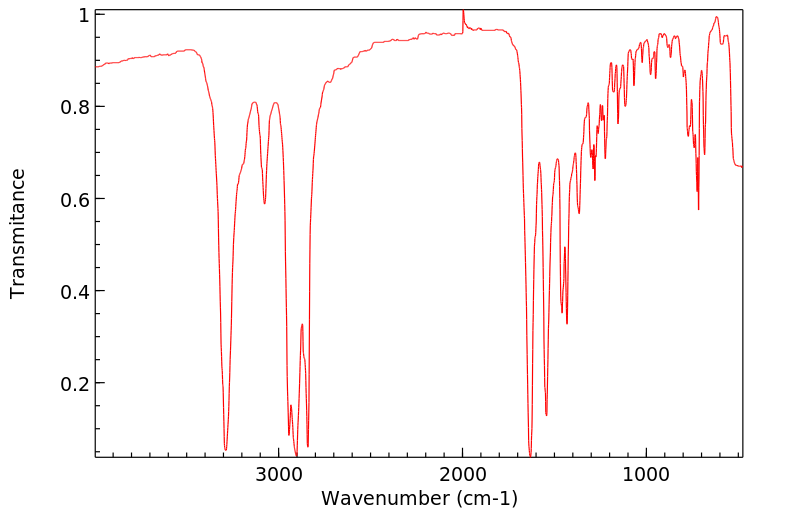N-butyldodecanamide | 6284-08-8
中文名称
——
中文别名
——
英文名称
N-butyldodecanamide
英文别名
Dodecanamide, N-butyl-
CAS
6284-08-8
化学式
C16H33NO
mdl
——
分子量
255.444
InChiKey
NTHVNXBUGUHNAH-UHFFFAOYSA-N
BEILSTEIN
——
EINECS
——
-
物化性质
-
计算性质
-
ADMET
-
安全信息
-
SDS
-
制备方法与用途
-
上下游信息
-
文献信息
-
表征谱图
-
同类化合物
-
相关功能分类
-
相关结构分类
物化性质
-
保留指数:2061
计算性质
-
辛醇/水分配系数(LogP):6
-
重原子数:18
-
可旋转键数:13
-
环数:0.0
-
sp3杂化的碳原子比例:0.94
-
拓扑面积:29.1
-
氢给体数:1
-
氢受体数:1
SDS
上下游信息
-
上游原料
中文名称 英文名称 CAS号 化学式 分子量 乙撑双月桂酰胺 dodecanamide, N,N'-1,2-ethanediylbis- 7003-56-7 C26H52N2O2 424.711
反应信息
-
作为反应物:参考文献:名称:仲酰胺一键还原功能化的一般方法摘要:描述了一锅反应,可将常见的仲酰胺转化为具有C-C键的胺。该方法包括的原位酰胺活化与TF 2 O形部分还原加成的Ç -nucleophiles。该方法的范围很广,可以同时使用硬亲核试剂(RMgX,RLi)和软亲核试剂以及烯醇盐。使用软的亲核试剂,在酯,氰基,硝基和叔酰胺基团存在的情况下,反应在仲酰胺上以高化学选择性进行。DOI:10.1021/jo502929x
-
作为产物:描述:参考文献:名称:Reaction of Amphipathic-Type Thioester and Amine with Hydrophobic Effect in Water摘要:标题反应采用了不同链长度的胺与三-(1-氧代十二烷-1-基)硫和三-(1-氧代庚烷-1-基)硫丙酸钠进行研究。发现酰胺的产率不仅依赖于硫酯的链长度,还依赖于胺的链长度,这表明存在疏水相互作用。在添加氟化钠后,酰胺的产率有所提高。还研究了一些疏水性氨基酸的酰化(十二酰化),以获得相应的酰胺。DOI:10.1055/s-0030-1261165
文献信息
-
Combining a Solution-Phase Derived Library with In-Situ Cellular Bioassay: Prompt Screening of Amide-Forming Minilibraries Using MTT Assay作者:Li-Wu Chiang、Kai Pei、Shao-Wei Chen、Ho-Lien Huang、Kun-Ju Lin、Tzu-Chen Yen、Chung-Shan YuDOI:10.1248/cpb.57.714日期:——We constructed a minilibrary using a solution-phase synthesis through coupling of three core amino compounds (5′-amino-5′-deoxy uridine, 5′-amino-2′,5′-di-deoxy arabinosyl uridine, and butan-1-amine) with 30 carboxylic acids via amide bond formation. The simplified structural core compound butan-1-amine was selectively coupled with 9 carboxylic acids as control. 3-(4,5-Dimethyl-2-thiazolyl)-2,5-diphenyl-2H-tetrazolium bromide assay of the crude mixtures showed that analogues derived from fenbufen, butylfenbufen C15; ethacrynic acid, butyl ethacrynic amide C18; and sphingosines, Sph-1, Sph-2 and U27 had an increased cytotoxicity against MCF-7 cells as well as A549 cells. Structural elucidation with molecular docking suggested that cytotoxicity of these compounds is mainly due to the inhibition of enzymes regulating cellular apoptosis.
-
Ethyl 2-(<i>tert</i>-Butoxycarbonyloxyimino)-2-cyanoacetate (Boc-Oxyma) as Coupling Reagent for Racemization-Free Esterification, Thioesterification, Amidation and Peptide Synthesis作者:Kishore Thalluri、Krishna Chaitanya Nadimpally、Maharishi Parasar Chakravarty、Ashim Paul、Bhubaneswar MandalDOI:10.1002/adsc.201200645日期:2013.2.1the synthesis and utility of ethyl 2-(tert-butoxycarbonyloxyimino)-2-cyanoacetate (Boc-Oxyma) as an efficient coupling reagent for racemization-free esterification, thioesterification, amidation reactions and peptide synthesis that uses equimolar amounts of acids and alcohols, thiols, amines or amino acids, respectively. Its application to solid phase as well as solution phase peptide synthesis is also
-
A catalyst-free, waste-less ethanol-based solvothermal synthesis of amides作者:Francesca Dalu、Mariano A. Scorciapino、Claudio Cara、Alberto Luridiana、Anna Musinu、Mariano Casu、Francesco Secci、Carla CannasDOI:10.1039/c7gc02967e日期:——
A green, one-pot ethanol-based solvothermal amidation of carboxylic acids which does not require catalysts or coupling reagents.
一种绿色的、一锅法的乙醇基溶剂热酰胺化反应,不需要催化剂或偶联试剂。 -
Direct Transformation of Secondary Amides into Secondary Amines: Triflic Anhydride Activated Reductive Alkylation作者:Kai-Jiong Xiao、Ai-E Wang、Pei-Qiang HuangDOI:10.1002/anie.201204098日期:2012.8.13transformation has been developed (see scheme; 2‐F‐Py=2‐fluoropyridine; Tf=trifluorosulfonyl). The amines are synthesized in good yields and the ketimine intermediates can be isolated before the reduction. This method should find applications in the synthesis of nitrogen‐containing bioactive molecules and medicinal agents.
-
Substrate-Selective Dehydrocondensation at the Interface of Micelles and Emulsions of Common Surfactants作者:Munetaka Kunishima、Kanako Kikuchi、Yukio Kawai、Kazuhito HiokiDOI:10.1002/anie.201107706日期:2012.2.27Scratch the surface: Dehydrocondensations between carboxylates and amines by using an amphiphilic 1,3,5‐triazinylammonium‐based coupling agent were accelerated by the interfacial effect of micelles and emulsions of common surfactants (see figure). The reaction of carboxylates was promoted by both anionic and nonionic surfactants, and that of amines was promoted by only a nonionic surfactant. High selectivities
表征谱图
-
氢谱1HNMR
-
质谱MS
-
碳谱13CNMR
-
红外IR
-
拉曼Raman
-
峰位数据
-
峰位匹配
-
表征信息
同类化合物
(±)17,18-二HETE
(±)-辛酰肉碱氯化物
(Z)-5-辛烯甲酯
(Z)-4-辛烯酸
(R)-甲羟戊酸锂盐
(R)-普鲁前列素,游离酸
(R,R)-半乳糖苷
(E)-4-庚烯酸
(E)-4-壬烯酸
(E)-4-十一烯酸
(9Z,12E)-十八烷二烯酸甲酯
(6E)-8-甲基--6-壬烯酸甲基酯-d3
(3R,6S)-rel-8-[2-(3-呋喃基)-1,3-二氧戊环-2-基]-3-羟基-2,6-二甲基-4-辛酮
龙胆二糖
黑曲霉二糖
黄质霉素
麦芽酮糖一水合物
麦芽糖醇
麦芽糖酸
麦芽糖基蔗糖
麦芽糖一水合物
麦芽糖
鳄梨油酸乙酯
鲸蜡醇蓖麻油酸酯
鲸蜡醇油酸酯
鲸蜡硬脂醇硬脂酸酯
鲸蜡烯酸脂
鲸蜡基花生醇
鲫鱼酸
鲁比前列素
鲁比前列素
高级烷基C16-18-醇
高甲羟戊酸
高效氯氰菊酯
高-gamma-亚油酸
马来酸烯丙酯
马来酸氢异丙酯
马来酸氢异丁酯
马来酸氢丙酯
马来酸氢1-[2-(2-羟基乙氧基)乙基]酯
马来酸单乙酯
马来酸单丁酯
马来酸二辛酯
马来酸二癸酯
马来酸二甲酯
马来酸二烯丙酯
马来酸二正丙酯
马来酸二戊基酯
马来酸二异壬酯
马来酸二异丙酯







